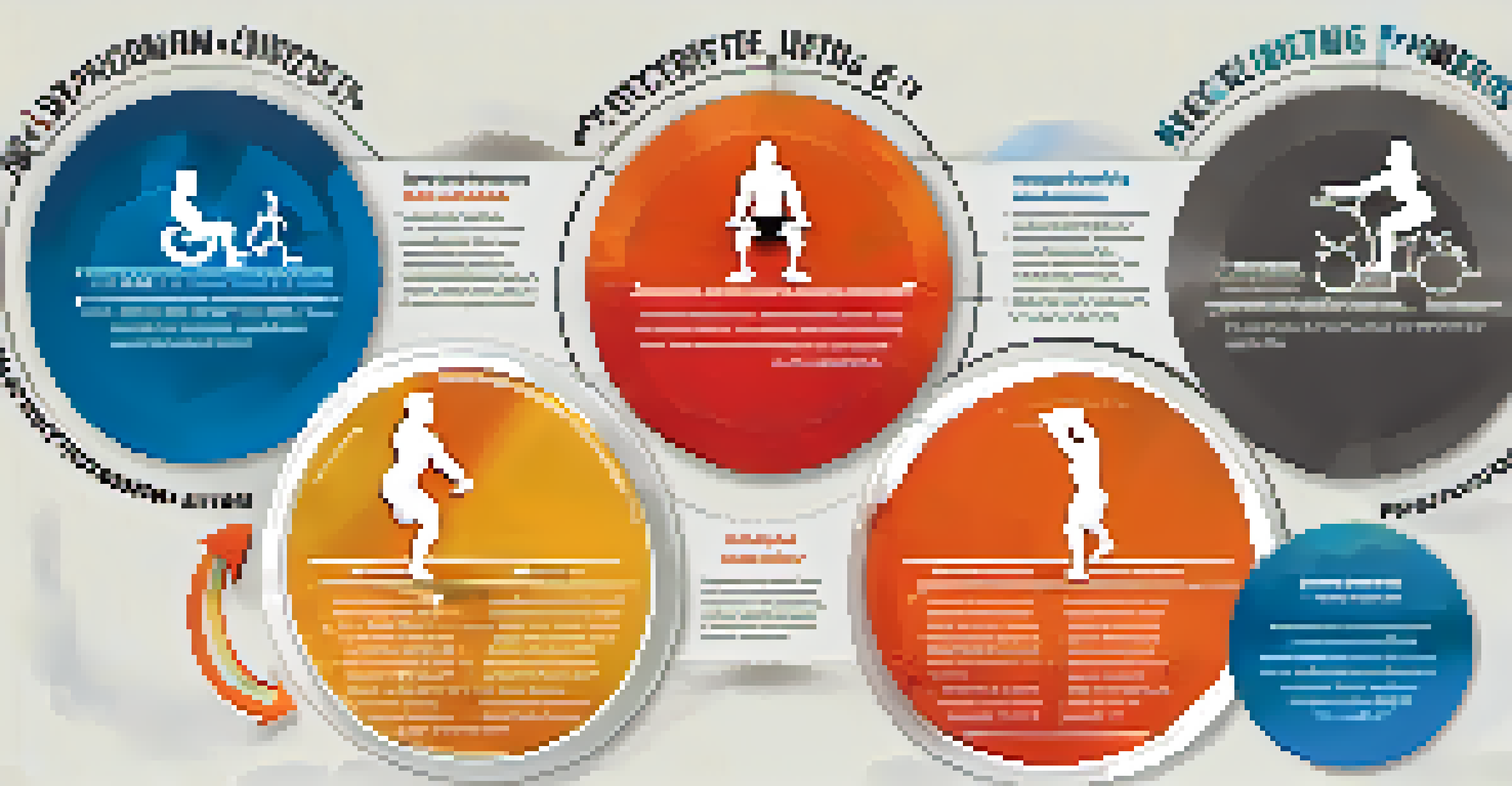An Introduction to Periodization in Powerlifting Training Plans

What is Periodization in Powerlifting?
Periodization is a systematic approach to training that involves varying your workout intensity and volume over time to optimize performance. In powerlifting, this means planning your training cycles to align with specific goals, such as preparing for a competition. By breaking down the training year into distinct phases, lifters can focus on different aspects of strength and recovery.
The key to success is to start before you are ready.
Think of periodization as a roadmap for your training; it guides you through the ups and downs of strength gains. Instead of just lifting heavier weights week after week, which can lead to burnout or injury, periodization allows for strategic planning. This method not only enhances performance but also helps to prevent plateaus, keeping your progress on track.
In essence, periodization helps powerlifters manage their energy and recovery effectively. By understanding and implementing this concept, you'll be better equipped to reach your lifting goals and maintain long-term growth in your training.
The Phases of Periodization Explained
Periodization typically consists of three main phases: the macrocycle, mesocycle, and microcycle. The macrocycle is the overarching plan that spans a year or more, focusing on long-term goals like competition preparation. Within this, mesocycles last several weeks to months and target specific training focuses, such as hypertrophy or strength development.

Microcycles are the smallest units, usually lasting a week, detailing daily training sessions. Each phase has a specific goal and involves varying intensities and volumes, which makes it easier for lifters to track progress and adapt their training. For instance, during a hypertrophy phase, you might perform more repetitions with lighter weights to build muscle mass.
Understanding Periodization Basics
Periodization involves structuring training cycles to optimize performance and prevent burnout in powerlifting.
Understanding these phases allows powerlifters to structure their training effectively. By strategically alternating between these cycles, athletes can maximize their performance and ensure they are prepared for peak strength at the right times.
Benefits of Periodization for Powerlifters
One of the primary benefits of periodization is that it reduces the risk of overtraining. By incorporating planned rest and recovery into your training cycles, you give your muscles and central nervous system time to adapt and grow stronger. This can lead to improved performance and decreased chances of injury, which is vital for anyone lifting heavy weights.
Success is the sum of small efforts, repeated day in and day out.
Additionally, periodization helps lifters stay mentally engaged in their training. Changing focus every few weeks keeps workouts fresh and exciting, preventing the monotony that can sometimes occur with traditional training methods. Lifters often find that this variety boosts motivation and enthusiasm, leading to better overall results.
Finally, periodized training allows for measurable progress tracking. With clear goals set for each phase, it's easier to assess what works and what doesn't. This data-driven approach can lead to more informed decisions about future training plans, ensuring continued improvement.
Common Mistakes in Powerlifting Periodization
Despite its benefits, lifters often make mistakes when implementing periodization. One common pitfall is not allowing sufficient recovery time between cycles. Overdoing it can lead to fatigue and stagnation in performance, which is counterproductive to the goals of periodization.
Another mistake is neglecting to adjust training based on individual progress. Every lifter responds differently to training stimuli, and sticking rigidly to a plan can hinder growth. It's crucial to be flexible and make adjustments based on how you feel and perform during each cycle.
Phases of Periodization Explained
The three main phases of periodization—macrocycle, mesocycle, and microcycle—help lifters target specific goals and track progress effectively.
Lastly, many lifters underestimate the importance of proper planning. Failing to outline clear goals for each phase can result in a lack of direction and focus in training. A well-structured plan is essential to maximizing the effectiveness of periodization in powerlifting.
How to Create Your Own Periodized Training Plan
Creating a periodized training plan starts with assessing your goals. Are you preparing for a competition, or are you looking to build general strength? Defining your primary objective will help shape the structure of your macrocycle and subsequent mesocycles, ensuring they align with your desired outcomes.
Next, consider the duration of your training cycles. A typical macrocycle lasts around 12 months, while mesocycles can range from 4 to 12 weeks. Once you've established the timeline, break it down into specific phases focused on hypertrophy, strength, and peaking, ensuring you allow adequate recovery between each.
Finally, don't forget to include assessment points throughout your training. Regularly testing your max lifts or tracking your progress can help you see how effective your plan is and make adjustments as necessary. This iterative approach ensures you're continuously moving toward your goals.
Adjusting Periodization for Different Experience Levels
When it comes to periodization, one size does not fit all. Beginner lifters might benefit from a simpler approach, focusing on basic strength development and technique. As they progress, they can introduce more complex periodization methods that incorporate varying intensities and volumes to further enhance their performance.
Intermediate lifters often find success with a three-phase approach that cycles through hypertrophy, strength, and peaking phases. This allows them to build a solid foundation while also preparing for heavier lifts. Tailoring the plan to the individual's progress and experience ensures that they are continuously challenged without risking injury.
Benefits of a Periodized Plan
A well-crafted periodized training plan reduces overtraining risks, keeps workouts engaging, and allows for measurable progress tracking.
Advanced lifters may need to implement more intricate periodization strategies, such as undulating or conjugate periodization. These methods offer greater complexity in training variables and are designed to keep seasoned athletes progressing. Regardless of experience level, the key is to adjust your plan based on your unique needs and goals.
Conclusion: Embracing Periodization in Powerlifting
In conclusion, periodization is an invaluable tool for powerlifters seeking to enhance their performance and reach their goals. By understanding its principles and applying them to your training, you can effectively manage your progress, prevent injuries, and stay motivated. Whether you’re a beginner or an experienced lifter, customizing your approach to periodization can lead to significant improvements in your lifting.
Remember, the essence of periodization lies in its flexibility and adaptability. Your training plan should evolve with you, adjusting to your progress, recovery, and changing goals. This dynamic approach not only keeps your training effective but also makes it enjoyable.

So, if you haven’t yet incorporated periodization into your powerlifting routine, now is the perfect time to start. Embrace this structured method, and watch as your lifts transform and your strength soars.